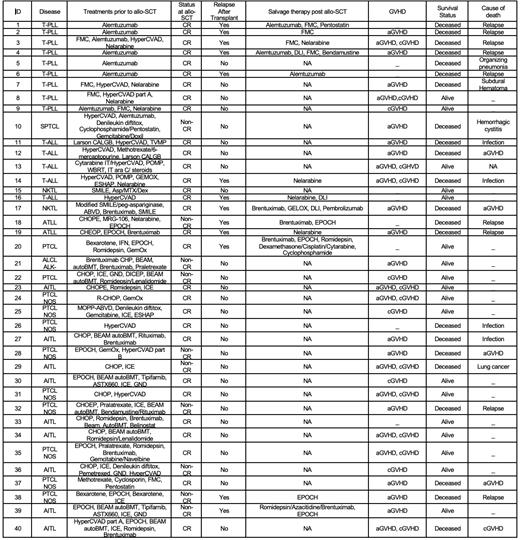Background: Allogeneic hematopoietic stem cell transplantation (alloSCT) is a potential curative option for patients with relapsed/refractory T-cell lymphoma (TCL).A reduced intensity conditioning (RIC) regimen of infusional pentostatin and 6 Gy of total body irradiation (TBI) has been shown to be well-tolerated and to have favorable engraftment kinetics 1. We utilized this regimen for patients with aggressive TCL undergoing alloSCT due to the demonstrated activity of pentostatin as a single agent in TCL and its potential impact, along with TBI, on eradicating residual TCL.
Methods: This retrospective review includes adult patients with Nodal TCL (PTCL , AITL, ALCL), rare aggressive TCL [(T-ALL, natural killer/T-cell lymphoma (NKTL), adult T-cell leukemia/lymphoma (ATLL), and subcutaneous panniculitis-like T-cell lymphoma (SPTCL)], and T-Prolymphocytic leukemia (TPLL) who underwent alloSCT between 2006 and 2021. The primary objective was to determine transplant related outcomes including grade 3-4 acute graft-versus-host disease (aGVHD), extensive chronic GVHD (cGVHD), relapse, non-relapse mortality (NRM), and overall (OS), relapse-free (RFS), and GVHD-free, relapse-free survival (GRFS) following transplant. A subgroup analysis was conducted to evaluate the impact of disease status at the time of transplant and other factors, including age and subtype of TCL.
Results: We report results for 40 patients (Nodal TCL: 21, Rare aggressive TCL: 10, T-PLL: 10) with a median age of 56.6 years ( range 24-71). Seventy-five percent were in clinical CR at the time of transplant. The 1-y cumulative incidence rate (CIN) of aGVHD was 42.5%. The 3-y CIN for cGVHD was 22.9. The median OS was 3.18 years with a 3-y OS rate of 51.9%. The median RFS was 1.24 years, with a 3-year RFS rate of 41.4%. OS and RFS were significantly higher in patients <65 compared to ≥65 (p-value 0.050 and 0.010 respectively), with no difference between the complete response (CR) and non-CR groups or different subtypes of TCL. The median GRFS was 0.52 years, with a 3-year GRFS rate of 20%. There was no statistically significant difference in GRFS or the incidence of GVHD between groups. Renal toxicity was noted in 10 patients. No cases of pulmonary or central nervous system (CNS) toxicities were observed. By day 100, 15 patients had an infection, including 8 bacterial infections and 5 viral infections. A total of 12 patients had reactivation of cytomegalovirus. Twelve patients died within the first year: 4 from relapse, 3 from aGVHD, 3 from infection, 1 from a subdural hematoma after a fall, and 1 from bladder perforation in the setting of hemorrhagic cystitis. Of 13 patients who relapsed, all received salvage therapy and 3 received DLI. Four are alive and in remission.
Conclusions: In patients with TCL, RIC for alloSCT was well tolerated and compared favorably with retrospective data from larger groups of patients from CIBMTR and EBMT who were transplanted with different regimens 2. Interestingly, transplant-related outcomes were similar for patients with CR vs partial response (PR) at the time of transplant, and outcomes were better in patients younger than 65. Relapsed patients had a poor outcome despite salvage therapy with only a 30% OS at 3 years.
1. Foss et al, Transfusion 2020
2. Hamadani et al, Blood Advances 2022
OffLabel Disclosure:
Foss:Daiichi Sankyo: Honoraria; Conjupro: Honoraria; Kyowa: Honoraria; SecuraBio: Honoraria; Acrotech: Speakers Bureau; Seagen: Speakers Bureau; Astex: Honoraria. Isufi:Incyte: Consultancy; Beam Therpauetics: Consultancy; Gilead: Consultancy, Current equity holder in publicly-traded company; Abbvie: Consultancy; Genmab: Consultancy; ADC Therapeutics: Consultancy.
Off-Label Use of Various FDA approved drugs in T-cell lymphoma


This feature is available to Subscribers Only
Sign In or Create an Account Close Modal